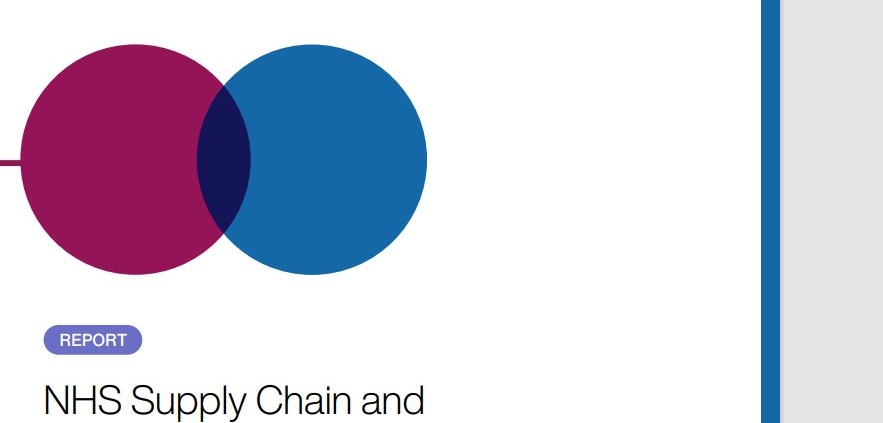What does NAO think about NHS Supply Chain?
Last month, the UK National Audit Office published “NHS Supply Chain and efficiencies in procurement”, a report looking particularly at the National Health Service’s Supply Chain organisation. Supply Chain (SC) acts as a central procurement “organisation”service provider”, putting in place contracts for a huge range of goods and services that can be used by hospitals and other NHS organisations.
It has a complex history, going back 50 years or so, which we won’t fully explore here. But after its perceived failure during the pandemic in terms of supplying PPE in particular, it has been going through yet another re-organisation or “transformation”. The operation of various “category towers” had been outsourced – although the outsourced service providers were actually other NHS procurement organisations in most cases. But now the category work is being brought back in house.
As we might have expected, the report paints a mixed picture but on balance, I would call it a somewhat worrying report. There is still a lot of mistrust between SC and procurement leaders in many health trusts. Much of that is historical, but more needs to be done.
One example of this is the “eDirect” service. SC operates a logistics service, delivering to NHS sites from its own warehouses. But it also runs “eDirect”, a direct delivery services from suppliers to the NHS – more of a “dropshipping” model, as it were. However, that has not been working well. The report says that procurement route accounted for around £1.5 billion of orders via Supply Chain in 2022-23, but more than a quarter of orders were delivered late, by an average 22 days, between June 2022 and March 2023. I hate making facile comparisons, but Amazon would be horrified if it was providing that level of service.
The mistrust also comes from issues such as the measurement and reporting of “savings” – basically, SCL reports big numbers to justify its existence, but many Trusts don’t recognise the numbers or feel that SCL is really delivering tangible savings they can see in their own organisation. In 2019, the Department of Health set Supply Chain a target to deliver £2.4 billion savings by 2023-24. SC told the NAO that it had exceeded its £2.4 billion savings target as of 2022-23, however NAO did not (or could not) validate this and there seems some confusion over how the rather weird savings methodology was initially agreed.
So it was interesting to see just yesterday (January 31st) Jacqui Rock, Commercial Director at NHS England, announcing a new unified savings measurement process for the NHS. We’ll see if this solves the problem.
Clearly, there is a lot of change going on in the Supply Chain organisation, and it has not all been plain sailing. I was worried around a year ago when two very good senior executives left Supply Chain suddenly (and not to go to better jobs) – not a sign of a happy ship. So how does NAO rate the effectiveness of the transformation programme? More concerns here;
“Transformation is not being run as a multi-year programme, instead it is managed on a year-by-year business cycle in line with NHSE’s business planning process. Supply Chain has not articulated clearly defined or measurable objectives with a detailed and costed timetable for delivery. There are gaps in Supply Chain’s senior leadership team and an over-reliance on the Chief Executive Officer. Recruitment of senior staff is being slowed by time taken for the civil service approvals process and the addition of an extra layer of approval for high-cost posts created by its move to NHSE …”
There are two sides to every story of course and some Trusts (and people within them) are guilty of pursuing procurement independence for their own reasons. But those reasons aren’t always selfish and the report is disappointing in the sense that it suggests that Trusts should make more use of Supply Chain, without really explaining why that would be a good thing, other than assuming bigger buyers get better deals.
“Supply Chain estimates that trusts spend approximately £3.4 billion outside of its function. Trusts are largely free to purchase goods outside Supply Chain. Supply Chain estimates that, as at September 2023, trusts’ annual procurement spend through Supply Chain was £4.5 billion with £3.4 billion spent outside of Supply Chain’s function”.
But is this lack of use of SC a good thing or a bad thing? Trusts cannot be forced into using Supply Chain given their legal independence, so there is always a tensions here, and I do wonder sometimes whether the NHS is just too big. I’ve argued for years – not just in the NHS context – that the benefits of aggregation and centralisation in procurement are almost always over-estimated. Trying to do effective “central procurement” in an organisation that employs 1.4 MILLION people in the UK is perhaps just too much to expect. I wouldn’t take on the Supply Chain CEO role for £1 million a year and a knighthood, so I do have sympathy for the team there, but maybe this is just an impossible task.









Leave a Reply
Want to join the discussion?Feel free to contribute!